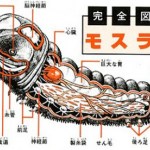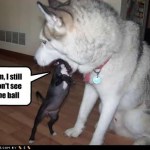animals
I'm back! For anyone wondering why I've been reposting old pieces for the last few weeks, it's because my wife and I were enjoying a much-deserved holiday in South Africa. I'll stick a link to some photos shortly, but for the moment, here's some post-holiday geekery for you.
The trip was a wildlife extravaganza. We spent four days in the Sabi Sands Game Reserve (just south of Kruger), as well as whale-watching, various walks through national parks and four fabulous hours tracking wild meerkats. I'll be sticking up details and photos over the coming weeks/months, but for now, here's a full…
Wow, their brains are small. It all makes sense now - all they want to do is eat shit and kill their competitors.
Anyone want to translate the, what I'm assuming, is Japanese for me?
-Via Neatorama-
This article is reposted from the old Wordpress incarnation of Not Exactly Rocket Science. The blog is on holiday until the start of October, when I'll return with fresh material.
Sex is, on the whole, a good thing. I know it, you know it, and natural selection knows it. But try telling it to bdelloid rotifers. These small invertebrates have survived without sex for some 80 million years.
While many animals, from aphids to Komodo dragons, can reproduce asexually from time to time, it's incredibly rare to find a group that have abandoned sex altogether. The bdelloid rotifers (pronounced…
tags: Birdbooker Report, bird books, animal books, natural history books, ecology books
"How does one distinguish a truly civilized nation from an aggregation of
barbarians? That is easy. A civilized country produces much good bird
literature."
--Edgar Kincaid
The Birdbooker Report is a special weekly report of a wide variety of science, nature and behavior books that currently are, or soon will be available for purchase. This report is written by one of my Seattle birding pals and book collector, Ian "Birdbooker" Paulsen, and is edited by me and published here for your information and…
This article is reposted from the old Wordpress incarnation of Not Exactly Rocket Science. The blog is on holiday until the start of October, when I'll return with fresh material.
It's tempting to think that elephants have their own PR agency. Just last week, their mighty reputation was damaged by the revelation that they are scared away by bees but they have bounced back with a new study that cements their standing among the most intelligent of animals.
Lucy Bates and colleagues from the University of St Andrews have found that African elephants (Loxodonta africana) can tell the…
This article is reposted from the old Wordpress incarnation of Not Exactly Rocket Science. The blog is on holiday until the start of October, when I'll return with fresh material.
In your garden, there's a fair chance that a farmer is currently tranquilising her livestock with a chemical cocktail she secretes from her feet. Don't believe me? Look closer...
Humans aren't the only species that farms other animals for food - ants do it too and their herds consist of aphids. They feed on plant sap and excrete a sweet and nutritious liquid called honeydew, which the ants drink.
In…
This article is reposted from the old Wordpress incarnation of Not Exactly Rocket Science. The blog is on holiday until the start of October, when I'll return with fresh material.
It's a myth that elephants are afraid of mice, but new research shows that they're not too keen on bees. Even though they fearlessly stand up to lions, the mere buzzing of bees is enough to send a herd of elephants running off. Armed with this knowledge, African farmers may soon be able to use strategically placed hives or recordings to minimise conflicts with elephants.
Iain Douglas-Hamilton and Fritz Vollrath…
This article is reposted from the old Wordpress incarnation of Not Exactly Rocket Science. The blog is on holiday until the start of October, when I'll return with fresh material.
For plants too, sex can be a hot and smelly affair. In most plant-insect partnerships, the pollinator seems to do most of the work by voluntarily transferring pollen from plant to plant in exchange for a meal.
But an ancient lineage of plants - the cycads - takes more active steps to ensure its future with a bizarre combination of heat and smells. In the afternoon, they use heat and a toxic stench to drive…
This article is reposted from the old Wordpress incarnation of Not Exactly Rocket Science. The blog is on holiday until the start of October, when I'll return with fresh material.
The sabre-toothed cat is one of the most famous prehistoric animals and there is no question that it was a formidable predator, capable of bringing down large prey like giant bison, horses, and possibly even mammoths. The two massive canines - the largest teeth of any mammal - are a powerful visual. But while they were clearly powerful weapons, scientists have debated their use for over 150 years.
Now, a new study…
tags: Birdbooker Report, bird books, animal books, natural history books, ecology books
"How does one distinguish a truly civilized nation from an aggregation of
barbarians? That is easy. A civilized country produces much good bird
literature."
--Edgar Kincaid
The Birdbooker Report is a special weekly report of a wide variety of science, nature and behavior books that currently are, or soon will be available for purchase. This report is written by one of my Seattle birding pals and book collector, Ian "Birdbooker" Paulsen, and is edited by me and published here for your information and…
tags: nature, animals, streaming video
This video points out that people are not the center of the universe, as so many of us think we are. And one of those animals that are superior to humans are the penguins. Can you think of why that might be?
For humans and most other mammals, sex is a question is chromosomes. Two X chromsomes makes us female while an X and a Y makes us male. Birds use a similar but reversed system, where males are ZZ and females are ZW. But for reptiles, including crocodiles, turtles and many lizards, sex is determined not by genes, but by temperature.
In crocodiles, males hatch from eggs incubated at cooler temperatures while warmer conditions produce females. In turtles, it's the other way around, and lizards use a variety of criteria including some very complicated combinations of genes, temperature…
The drawers of the world's museums are full of pinned, preserved and catalogued insects. These collections are more than just graveyards - they are a record of evolutionary battles waged between animals and their parasites. Today, these long-dead specimens act as "silent witnesses of evolutionary change", willing to tell their story to any biologist who knows the right question to ask.
This time round, the biologist was Emily Hornett, currently at UCL, and her question was "How have the ratios of male butterflies to female ones changed over time?" You would think that the sex ratios of…
When food is precious, animals can resort to strange behaviours in order to satisfy their hunger. Take the great tit. Its usual diet of insects and creepy-crawlies is harder to come by in winter. But in one Hungarian cave, great tits, ever the opportunists, have learned to exploit a rich and unusual source of food. They kill sleeping bats.
Great tits are only about 5 inches long, but their prey - the pipistrelle bat - is smaller still, just an inch or two in size. The bats spend the winter months hibernating in rock crevices. They're well hidden, but when they wake up, they start making…
When danger threatens many lizards can detach their tails, leaving them behind as decoys in the hope that the predator will attack it rather than the lizard itself. But the tail doesn't just lie there as bait. For half an hour after they've been severed, the disembodied tails perform a complex dance, flipping, lunging and jumping up to an inch in the air. These acrobatics serve to distract the predator even further.
For the first time, Timothy Higham and Anthony Russell have studied the movements of severed gecko tails to understand how they can move in such complex ways without any input…
tags: nature, birds, gannet, Morus serrator, technology, BBC, streaming video
Steve Leonard and a group of conservationists attach tiny gadgets to the feathers of a Gannet, Morus serrator, to learn how they eat and fly out in the deep oceans. Great short video from BBC wildlife show Animal Camera.
The natural world is rife with leftovers. Over the course of evolution, body parts that no longer benefit their owners eventually waste, away leaving behind shrivelled and useless anatomical remnants. The human tailbone is one such example. Others include the sightless eyes of cavefish that live in total darkness, the tiny spurs on boas and pythons that hint at the legs of their ancestors, and the withered wings of the Galapagos cormorant, an animal that dispensed with flight on an island bereft of land predators.
Animal genomes contain similar remains. Just like organs, genes also waste…
tags: Birdbooker Report, bird books, animal books, natural history books, ecology books
"How does one distinguish a truly civilized nation from an aggregation of
barbarians? That is easy. A civilized country produces much good bird
literature."
--Edgar Kincaid
The Birdbooker Report is a special weekly report of a wide variety of science, nature and behavior books that currently are, or soon will be available for purchase. This report is written by one of my Seattle birding pals and book collector, Ian "Birdbooker" Paulsen, and is edited by me and published here for your information and…
Domestic dogs are very different from their wolf ancestors in their bodies and their behaviour. They're more docile for a start. But man's best friend has also evolved a curious sensitivity to our communication signals - a mental ability that sets them apart from wolves and that parallels the behaviour of human infants. Dogs and infants are even prone to making the same mistakes of perception.
Like infants less than a year old, dogs fail at a seemingly easy exercise called the "object permanence task". It goes like this: if you hide an object somewhere(say a ball under a cup) and let…

